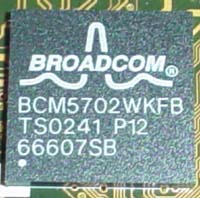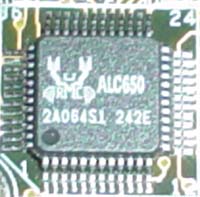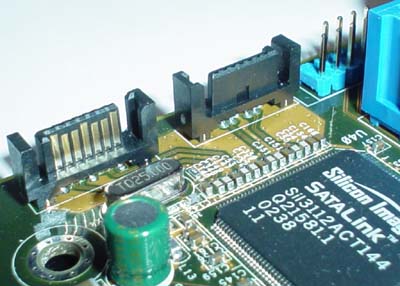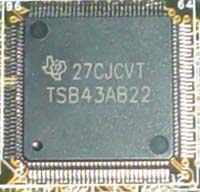Intel's E7205: Granite Bay Hits the Streets
by Evan Lieb on November 18, 2002 9:56 AM EST- Posted in
- Motherboards
ASUS P4G8X Deluxe: Basic Features
|
Motherboard Specifications |
|
|
CPU
Interface
|
Socket-478
|
|
Chipset
|
Intel
E7205 MCH
Intel 82801DB ICH4 |
|
Bus
Speeds
|
100
- 400MHz (in 1MHz increments)
|
|
Core
Voltages Supported
|
up
to 1.975V (in 0.025V increments)
|
|
I/O
Voltages Supported
|
N/A
|
|
DRAM
Voltages Supported
|
up to 2.7V
in 0.1V increments
|
|
Memory Slots
|
4 184-pin
DDR DIMM Slots
|
|
Expansion Slots
|
1 AGP
8X Slot
5 PCI Slots |
|
Onboard RAID
|
N/A
|
|
Onboard USB 2.0/IEEE-1394
|
USB
2.0 supported through South Bridge
TI TSB43AB22 FireWire Controller |
|
Onboard LAN
|
Broadcom
5702 Gigabit LAN
|
|
Onboard Audio
|
Realtek
ALC650
|
|
Onboard Serial ATA
|
Silicon
Image 3112A controller
|
|
BIOS
Revision
|
1001
|
Taking a quick peak at all the features the P4G8X offers, we can clearly see that ASUS is staying with their series of cutting-edge features motherboards, now called the Deluxe series of ASUS motherboards. As an all-in-one solution (minus VGA), ASUS's Deluxe series looks to be a real winner now and into the foreseeable future. Only ABIT's MAX series is as competitive.
One of the first features we happened to notice was the LAN chip ASUS decided to use with their P4G8X. This isn't your usual LAN chip; in actuality, it's a Gigabit LAN chip, which supports up to 1000Mbit/s bandwidth. The Gigabyte LAN is powered by Broadcom's 5702 chip, one we're quite familiar with at this point. Setting up this particular Gigabit LAN was no more difficult than any of the other thousands of 10/100 solutions we've configured. Unfortunately, there aren't a lot of mainstream users (that includes your Joe Average as well as your power user) that will be able to take advantage of Gigabit support. This technology is usually regulated to small businesses or any institution for that matter that requires a large network.

ASUS doesn't choose a very intriguing sound chip despite the high-end nature of this motherboard. A simple and very mainstream Realtek ALC650 codec is chosen to power the onboard sound of the P4S8X. This sound solution offers nothing special or interesting compared to other solutions we've used before.

The P4G8X's I/O configuration isn't all that unusual either. We see some pretty common features like two PS/2 ports, two serial ports, one parallel port, four rear USB 2.0 ports, a Gigabit LAN port, and Mic In, Line In, and Line Out, which drive the onboard sound. No dual LAN here, but Gigabit should be adequate for most.

ASUS uses a Serial ATA chip we've seen on several motherboards before, including Intel's D845PEBT2, Epox's 4PEA+, and ECS's L4S8A. This SATA chip turns up on ASUS's P4G8X Deluxe board, dubbed the Silicon Image 3112A. This chip is capable of supporting up to two independent Serial ATA devices as well as RAID 0 (striping) and RAID 1 (mirroring). While certainly a nice feature, all current onboard Serial ATA implementations use the PCI bus, which translates into limited bandwidth. We would rather see native Serial ATA support in a chipset, because this way a Serial ATA device won't have to fight for bandwidth with other PCI devices, whereas the current implementation on modern-day motherboards are forced to travel through the PCI bus.

As far as IDE support goes, the ASUS P4G8X doesn't come with an abundance of options. The Primary and Secondary IDE connectors support two channels each, or four IDE devices in total. This is good only if you're the type that doesn't need more than a DVD drive, CD-RW drive, two hard drives, or some other combination thereof. Therefore, if you need to connect more than four drives or desire onboard IDE RAID, the P4G8X isn't for you.
The E7205 chipset provides support for USB 2.0 like its 845PE predecessor. The Intel ICH4 South Bridge makes this support possible; up to six USB 2.0 ports total. The P4G8X doesn't include any additional USB 2.0 support (for example, through a separate onboard USB 2.0 chip), but the P4G8X already has four rear USB 2.0 ports in addition to a two-port USB bracket that you can plug into the onboard USB header and which is bundled with the Deluxe Edition, so not too many people should be disappointed.
Another technology we like to see included is FireWire support. While there aren't any rear FireWire ports, there are two (red) FireWire headers at the bottom of the P4G8X. The headers are powered by TI's TSB43AB22 FireWire controller, which supports no more than two FireWire ports. If you're interested in how this FireWire controller works, head on over to TI's features page on the TSB43AB22, they list all the features about this controller that you could want to know.











2 Comments
View All Comments
hrumsey - Friday, January 7, 2005 - link
Regarding previous comment:And I told this thing to show e-mail address. hrumsey@charter.net if anyone has questions.
It also removed paragraph indents that would make the above post a bit more readable- apologies.
And a clarification: The ZCR card could be seen to be flashed only because a jumper change is needed to put them in flash mode. In normal mode, the Thunder K8S Pro S2882 BIOS was squashing the Adaptec 2010S / 2015S BIOS.
Damn, I hope Google indexes that comment well.
Speaking of which, for you-know-who:
Tyan Thunder K8S Pro Adaptec 2010S 2015S ZCR RAID BIOS problem incompatibility bug hang failure download flash PCI-X
Tyan 2882 K8S Pro Thunder ZCR Adaptec 2015S 2010S RAID bug hang failure problem incompatibility PCI-X flash BIOS download
Thunder Tyan 2882 K8S Pro ZCR Adaptec RAID 2010S 2015S BIOS incompatibility problem failure hang PCI-X BIOS bug flash download
wildly incompetent screen-reading technical support monkeys
beta-testing on customers
See previous comment
hrumsey - Friday, January 7, 2005 - link
Anandtech's evaluation covers how good Tyan's tech support is in the absence of any real problem for them to deal with. I would suggest that this is not an adequate criterion.Our experiences were different.
The issue of product quality is relevant here, since it makes the quality of technical support more important if the product is poor. My company tried Tyan boards several years ago, and gave up when along with 4 DOAs, 3 quick in-service failures gave a defective rate of almost 50%. I mistakenly thought almost 10 years would be enough for the company to straighten out.
We ordered 3 Thunder Pro S2882s for a client taking a website inhouse who wanted a 64-bit option- this was before Intel's 64-bit Xeons showed up.
All of the following happened under time pressure, which isn't unusual, and why better support than Tyan's is necessary:
One of the three boards was DOA; wouldn't flash any of three Adaptec 2010S ZCR cards; the other two would. Tyan's tech support essentially kept assuming we were doing something wrong and, and at one point asked if we had the current BIOS on the ZCR cards. They must not have any sort of decent database, since the problem had to be explained anew every call. After they admitted the board was bad, they failed to warn us of their shipping deadline for replacing the board (which they will do, and with an E. Coast vendor and them in CA was necessary).
All the boards failed to see the ZCR cards. First tech said that couldn't be happening, second knew about the problem and said the "E" BIOS fixed it. It didn't. We delivered servers with drives unmirrored.
Site setup was busy for a while. When I finally had a chance to work on ZCR problem, Tyan could find no record of the problem (none of the emails we exchanged except ones I sent had case #s in the header). I explained everything again, and once again had to assure them again that we'd gotten the obvious stuff right. First tech said he didn't know how it could be happening, and thought I was missing something. Got email next day from supervisor acknowledging there was a problem and saying (again) they had a new BIOS out that would fix the problem. Downloaded, sent tech onsite to install. Didn't work, same result- ZCR card option grayed out in BIOS, system hangs. When I had a chance to go down and work on it personally, once again, no record of case. I went through everything from scratch once more, assuring them that yes, we'd read the FAQs and yes, the system was plugged in, and yes, we had tried every possible combination of their two blasted relevant jumpers, and that in fact there were about eight other germane parameters we had tried which none of them had thought of- and all of this while wasting valuable onsite time. When I finally convinced them that 1) we were competent and 2) it wasn't working, I was told I'd get a call back "shortly" from the responsible engineer. Three hours later, in a darkened factory, at 5:14:55 just as I was leaving, I got a call back from the engineer who actually knew what was going on. He finally admitted we had everything right. He had no solution, but agreed with my suggestion for testing and said he'd check- he lacked authority(!)- to see if management would authorize the replacement board I'd been asking for. And they did, but there shouldn't have been any question.
Next trip down I replaced the board in one server, picking the server in whichhe Gigabit Ethernet ports had failed- and it still didn't #$%^& work. Tyan said it had been working the day before for them with a 2010S ZCR card, and until today, I didn't know whether they were lying or not. I cussed some and ordered $1200 worth of controllers to replace what Tyan couldn't get right 5 months after the product's release.
Today I checked and saw that they have a new BIOS for the board available that "Fixes PCI ZCR card hangs system during POST". It's the third BIOS for which they've made that claim, and you know, it really doesn't matter whether they're right this time or not. And if they're not, it doesn't matter whether they're just mistaken or actually lying- theend result is the same.
We saw five of their high-end server boards. One DOA, one in-service failure, all five with a major design flaw. Eight years is enough time to take care of company-wide failures. Any company that will release a $500 server board with a 40% failure rate, and without first ensuring that everything on it actually works, and who then can't tell for five months whether or not they've fixed the resulting problems, and whose tech support is staffed with folks who can't deal those problems- well, that's a company whose products you want to steer very clear of.